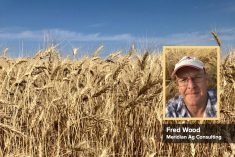Soil and rotation
- Oats grow best in black and grey wooded soil zones that have higher moisture, but can grow on sandy loam to heavy clay soils as long as they have good drainage.
- To reduce disease pressure and optimize yields, oats should not be grown after cereals. The best rotational crops include canola, hay, soybeans and other legumes. Research has shown that canola grown on oat stubble has 24 per cent more yield, while canola on wheat and barley stubble increased yield by only 18 and 19 per cent, respectively. Corn isn’t the best choice in rotation with oats because it increases the risk of some diseases and ties up N early in the growing season. That said, U.S. research has shown that sandwiching a year of oats between a corn/soybean rotation almost eliminates corn rootworm issues.
Read Also

Agronomists share tips for evaluating new crop products and tech: Pt. 3
With new products, new production practices and new technology converging on the agriculture industry at a frenetic pace in recent…
Seeding
- Earlier-seeded oats generally give increased yields and quality. In general, seeding by the middle of May in Western Canada gives optimum yield and quality. Ideal soil temperature for oats is above 5 C.
- Seed treatments can be used to help prevent seed- and soil-borne diseases. In cool, wet growing conditions they can help prevent root rot. Seed treatments are recommended for hulless oats because they are more susceptible to seed diseases.
- The recommended seeding rate for oats in Western Canada is to achieve 20 to 30 plants per sq./ft. Growers should use the higher seeding rate of this range in high-moisture, high-fertility, late seeding and high wild-oat competition situations. Seeding rates can be calculated using thousand kernel weights (TKW) times survival percentage (the percentage of seeds expected to germinate and produce vigorous seedlings). Under normal growing conditions growers should expect 95 per cent germination, but in cold, wet soil, germination could be 90 to 93 per cent.
- Growers should increase seeding rate of hulless oats because their fragile, thin seed covering can reduce germination.
- The optimum seeding depth for oats is one to two inches — deep enough to reach soil moisture — and should not exceed three inches.
- Oats are usually seeded with a row spacing of 7.5 to 12 inches but research has shown that in no-till systems wider row spacing up to 14 inches does not affect plant numbers or tillering. Wider row spacing may result in increased wild oats and, in dry conditions, may cause harvest issues if there is not enough stubble to hold the swath off the ground.
- Some research suggests that oat seed size may be important for competition with wild oats. A 2005 greenhouse study at the University of Saskatchewan showed that oats derived from large seed produced 17 per cent more biomass and 15 per cent more panicles (flower clusters) than plants derived from smaller seed regardless of genotype or wild oat competition.
Fertilization
- Oats in a no-till situation remove fewer nutrients from the soil — except sulphur — than barley, wheat or canola.
- Nitrogen (N) is the most yield-limiting nutrient in oats and a soil test is recommended to determine the amount of N growers need to apply. Too much N reduces test weight and the percentage of plump kernels, and also increases lodging. Too little N reduces tillering and yield.
- N requirement depends on moisture availability. Yield potential is higher with more moisture, and so a higher N rate is required to achieve optimum yield. A 100 bu./ac. oat crop generally requires 97 to 117 lbs./ac. N. Agriculture & Agri-Food Canada (AAFC) researchers at Brandon and Indian Head confirmed that under normal conditions optimal yields were achieved when soil plus applied N was at 89 lbs./ac., which is around 36 to 71 lbs./ac. of applied N, depending on the residual.
- There are situations when a P application may be beneficial such as on newly broken land, fallow fields, seeding into cold, wet soils or on sandy soils. An application of 18 to 28 lbs./ac., half applied with the seed, is usually adequate to produce optimum yields.
- Oat response to potassium (K) only occurs when soil test levels are below 280 lbs./ac., and soils that are sandy to sandy-loam or poorly drained are more prone to K deficiency. In cold, wet soils, an application of 15 lbs./ac. of K chloride (0-0-60) in the seed row may result in a crop response. Applications higher than 18 lbs./ac. should be side-banded or broadcast to avoid seedling damage.
- Oats have one of the highest requirements for sulphur (S). An application of nine to 15 lbs./ac. of sulphate is usually sufficient in most soils to correct the deficiency and provide for optimum yields.
- Of all the micronutrients, oats are most susceptible to manganese deficiency, especially in high-pH or sandy soils low in organic matter, and can be cured with an application of manganese.
Preventing disease
- Crown rust is the most prevalent and destructive disease in oats in Western Canada. It reduces yields, lowers test weight and groat percentage and increases lodging by weakening the oat stem. The disease-bearing spores blow in from the southern U.S., but can also be produced locally on buckthorn bushes. Ideal conditions for crown rust to develop are when daytime temperatures range from 25 C to 30 C and are 15 C to 20 C at night, with dew and adequate moisture.
- Growers should choose resistant varieties to control crown rust. Fungicides are available, and growers should pencil in the cost of a fungicide application if they are seeding a susceptible variety like AC Morgan. Research has shown that use of a fungicide is unlikely to improve yield when early planting is combined with a moderately crown rust-resistant variety. It is recommended that growers plant early with a moderately crown rust-resistant oat cultivar to avoid the need for fungicides.
- Barley yellow dwarf virus (BYDV) is spread by aphids blown into Canada from the southern U.S. and can result in low test weight. There are no resistant varieties, but planting early can help reduce damage.
- Most oat varieties are resistant to smut, and seed treatments are also an effective control. Fusarium head blight (FHB) is a fungal disease of most concern in Manitoba. It causes significant yield losses but can be hard to detect in oats. It’s most common in black soil zones and with high moisture conditions at flowering, but can also spread through wind and planting of infected seed.
- Oats are not susceptible to many insects, although cutworms, wireworms and aphids can cause damage to oat crops. Provincial crop protection guides list registered insecticides for oats.
Weed management
- Integrated weed management options give the best results. Wild oats remain a major concern for oat growers as there are no herbicide products currently registered for in-crop wild oat control.
- Growers do have herbicide options to control broadleaf weeds in oats, but increasing seeding rates, controlling weeds prior to seeding by tillage or herbicide application, and varying seeding rates are good management strategies for wild oats.
- Higher seeding rates and banding fertilizer adjacent to the seed can increase plant populations and make them more competitive, and using a larger seed size may also help to increase plant biomass. When seeding at higher rates growers should choose varieties with good lodging resistance as there is a higher risk of lodging.
- Growers can also plan rotations to reduce weed pressure. Using herbicides in rotational crops before or after oats and growing perennial forage crops for a few years are good long-term strategies for reducing wild oat populations.
- Herbicides containing 2,4-D should be avoided on oats as they have been shown to cause considerable yield reduction. Products containing dicamba should be used according to the stage restrictions on the label and not used under stress conditions.
Harvesting and storage
- Timing of harvest is critical to avoid damage to oat hulls, thereby reducing quality and yield. Oats should be swathed when kernel moisture content is about 35 per cent to avoid negative impacts on groat yield and test weight. Oats are ready to swath when the panicle has turned yellow or brown and the least mature kernels have turned a cream colour. Oats left too long in the field can weather, lose quality and shatter during storms.
- Straight combining oats may be an option but growers should ensure no green hulls are present or the oats will not make milling grade. If oats are left too long in the field before straight cutting, weather may cause the stems to break down and reduce yield.
- Prevent damage to oat hulls by reducing cylinder speeds to around 900 r.p.m. and allowing wider concave clearances. Oat buyers discount oats with a high percentage of de-hulled kernels, so growers should aim for less than five per cent de-hulled kernels through harvest, storage and delivery.
- Growers should be cautious about using a pre-harvest glyphosate application on oats. Major oat buyer Grain Millers no longer accepts oat shipments that have received pre-harvest glyphosate because of concerns about the functionality of the oat during milling. Some markets also have strict limits on the allowable glyphosate residues in oats, which could affect their saleability.
- Oat spoilage occurs when initial temperatures range from 0 C to 21 C with respective moisture from eight to 17 per cent. The Canadian Grain Commission has safe storage guidelines for storing grain on its website.
The Prairie Oat Growers Manual is available at the Prairie Oat Growers Association website.

















